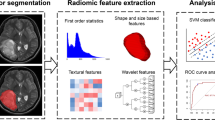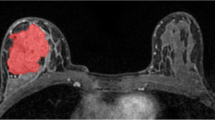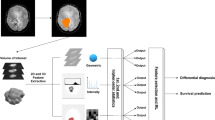Abstract
Objective
To identify the magnetic resonance imaging (MRI) features associated with epidermal growth factor (EGFR) expression level in lower grade gliomas using radiomic analysis.
Methods
270 lower grade glioma patients with known EGFR expression status were randomly assigned into training (n=200) and validation (n=70) sets, and were subjected to feature extraction. Using a logistic regression model, a signature of MRI features was identified to be predictive of the EGFR expression level in lower grade gliomas in the training set, and the accuracy of prediction was assessed in the validation set.
Results
A signature of 41 MRI features achieved accuracies of 82.5% (area under the curve [AUC] = 0.90) in the training set and 90.0% (AUC = 0.95) in the validation set. This radiomic signature consisted of 25 first-order statistics or related wavelet features (including range, standard deviation, uniformity, variance), one shape and size-based feature (spherical disproportion), and 15 textural features or related wavelet features (including sum variance, sum entropy, run percentage).
Conclusions
A radiomic signature allowing for the prediction of the EGFR expression level in patients with lower grade glioma was identified, suggesting that using tumour-derived radiological features for predicting genomic information is feasible.
Key Points
• EGFR expression status is an important biomarker for gliomas.
• EGFR in lower grade gliomas could be predicted using radiogenomic analysis.
• A logistic regression model is an efficient approach for analysing radiomic features.



Similar content being viewed by others
Abbreviations
- AUC:
-
Area under the curve
- EGFR:
-
Epidermal growth factor receptor
- MRI:
-
Magnetic resonance imaging
- ROC:
-
Receiver operating characteristic
References
Chen B, Liang T, Yang P et al (2016) Classifying lower grade glioma cases according to whole genome gene expression. Oncotarget 7:74031–74042
Fan X, Wang Y, Zhang C et al (2016) ADAM9 Expression Is associate with glioma tumor grade and histological type, and acts as a prognostic factor in lower-grade gliomas. Int J Mol Sci 17
Davis SC, Samkoe KS, O'Hara JA et al (2010) MRI-coupled fluorescence tomography quantifies EGFR activity in brain tumors. Acad Radiol 17:271–276
Ramos-Suzarte M, Lorenzo-Luaces P, Lazo NG et al (2012) Treatment of malignant, non-resectable, epithelial origin esophageal tumours with the humanized anti-epidermal growth factor antibody nimotuzumab combined with radiation therapy and chemotherapy. Cancer Biol Ther 13:600–605
Reddy BK, Lokesh V, Vidyasagar MS et al (2014) Nimotuzumab provides survival benefit to patients with inoperable advanced squamous cell carcinoma of the head and neck: a randomized, open-label, phase IIb, 5-year study in Indian patients. Oral Oncol 50:498–505
Rodríguez MO, Rivero TC, Del Castillo Bahi R et al (2014) Nimotuzumab plus radiotherapy for unresectable squamous-cell carcinoma of the head and neck. Cancer Biol Ther 9:343–349
Basavaraj C, Sierra P, Shivu J, Melarkode R, Monte E, Nair P (2014) Nimotuzumab with chemoradiation confers a survival advantage in treatment-naïve head and neck tumors over expressing EGFR. Cancer Biol Ther 10:673–681
Chong DQ, Toh XY, Ho IA et al (2015) Combined treatment of Nimotuzumab and rapamycin is effective against temozolomide-resistant human gliomas regardless of the EGFR mutation status. BMC Cancer 15:255
Xu S, Ramos-Suzarte M, Bai X, Xu B (2016) Treatment outcome of nimotuzumab plus chemotherapy in advanced cancer patients: a single institute experience. Oncotarget 7:33391–33407
Gupta A, Young RJ, Shah AD et al (2015) Pretreatment Dynamic Susceptibility Contrast MRI Perfusion in Glioblastoma: Prediction of EGFR Gene Amplification. Clin Neuroradiol 25:143–150
Yoo RE, Choi SH, Cho HR et al (2013) Tumor blood flow from arterial spin labeling perfusion MRI: a key parameter in distinguishing high-grade gliomas from primary cerebral lymphomas, and in predicting genetic biomarkers in high-grade gliomas. J Magn Reson Imaging 38:852–860
Bai HX, Lee AM, Yang L et al (2016) Imaging genomics in cancer research: limitations and promises. Br J Radiol 89:20151030
Drabycz S, Roldan G, de Robles P et al (2010) An analysis of image texture, tumor location, and MGMT promoter methylation in glioblastoma using magnetic resonance imaging. Neuroimage 49:1398–1405
Korfiatis P, Kline TL, Coufalova L et al (2016) MRI texture features as biomarkers to predict MGMT methylation status in glioblastomas. Med Phys 43:2835
Wang Y, Fan X, Zhang C et al (2014) Identifying radiographic specificity for phosphatase and tensin homolog and epidermal growth factor receptor changes: a quantitative analysis of glioblastomas. Neuroradiology 56:1113–1120
Ricard D, Kaloshi G, Amiel-Benouaich A et al (2007) Dynamic history of low-grade gliomas before and after temozolomide treatment. Ann Neurol 61:484–490
Kinoshita M, Sakai M, Arita H et al (2016) Introduction of High Throughput Magnetic Resonance T2-Weighted Image Texture Analysis for WHO Grade 2 and 3 Gliomas. PLoS One 11, e0164268
Wang Y, Fan X, Li H et al (2015) Tumor border sharpness correlates with HLA-G expression in low-grade gliomas. J Neuroimmunol 282:1–6
Wang YY, Zhang T, Li SW et al (2015) Mapping p53 mutations in low-grade glioma: a voxel-based neuroimaging analysis. AJNR Am J Neuroradiol 36:70–76
Aerts HJ, Velazquez ER, Leijenaar RT et al (2014) Decoding tumour phenotype by noninvasive imaging using a quantitative radiomics approach. Nat Commun 5:4006
Herold CJ, Lewin JS, Wibmer AG et al (2016) Imaging in the Age of Precision Medicine: Summary of the Proceedings of the 10th Biannual Symposium of the International Society for Strategic Studies in Radiology. Radiology 279:226–238
Kickingereder P, Burth S, Wick A et al (2016) Radiomic Profiling of Glioblastoma: Identifying an Imaging Predictor of Patient Survival with Improved Performance over Established Clinical and Radiologic Risk Models. Radiology 280:880–889
Zhang B, Chang K, Ramkissoon S et al (2016) Multimodal MRI features predict isocitrate dehydrogenase genotype in high-grade gliomas. Neuro-Oncology. doi:10.1093/neuonc/now121:now121
Segal E, Sirlin CB, Ooi C et al (2007) Decoding global gene expression programs in liver cancer by noninvasive imaging. Nat Biotechnol 25:675–680
Qiao XJ, Ellingson BM, Kim HJ et al (2015) Arterial spin-labeling perfusion MRI stratifies progression-free survival and correlates with epidermal growth factor receptor status in glioblastoma. AJNR Am J Neuroradiol 36:672–677
Tykocinski ES, Grant RA, Kapoor GS et al (2012) Use of magnetic perfusion-weighted imaging to determine epidermal growth factor receptor variant III expression in glioblastoma. Neuro Oncol 14:613–623
Apostolova I, Ego K, Steffen IG et al (2016) The asphericity of the metabolic tumour volume in NSCLC: correlation with histopathology and molecular markers. Eur J Nucl Med Mol Imaging. doi:10.1007/s00259-016-3452-z
Lindberg OR, McKinney A, Engler JR et al (2016) GBM heterogeneity as a function of variable epidermal growth factor receptor variant III activity. Oncotarget. doi:10.18632/oncotarget.12600
Hofer S, Lassman AB (2010) Molecular markers in gliomas: impact for the clinician. Target Oncol 5:201–210
Hu X, Miao W, Zou Y, Zhang W, Zhang Y, Liu H (2013) Expression of p53, epidermal growth factor receptor, Ki-67 and O6-methylguanine-DNA methyltransferase in human gliomas. Oncol Lett 6:130–134
Author information
Authors and Affiliations
Corresponding authors
Ethics declarations
Guarantor
The scientific guarantor of this publication is Tao Jiang.
Conflict of interest
The authors of this manuscript declare no relationships with any companies whose products or services may be related to the subject matter of the article.
Funding
This study has received funding by the National Natural Science Foundation of China (No. 81601452).
Statistics and biometry
Mr Kaibin Xu kindly provided statistical advice for this manuscript.
Informed consent
Written informed consent was not required for this study because the data were collected retrospectively in the study.
Ethical approval
Institutional review board approval was obtained.
Methodology
• retrospective
• diagnostic or prognostic study
• performed at one institution
Additional information
Yiming Li and Xing Liu contributed equally to this work
Electronic supplementary material
Below is the link to the electronic supplementary material.
Supplementary Table 1
(DOCX 15 kb)
Rights and permissions
About this article
Cite this article
Li, Y., Liu, X., Xu, K. et al. MRI features can predict EGFR expression in lower grade gliomas: A voxel-based radiomic analysis. Eur Radiol 28, 356–362 (2018). https://doi.org/10.1007/s00330-017-4964-z
Received:
Revised:
Accepted:
Published:
Issue Date:
DOI: https://doi.org/10.1007/s00330-017-4964-z




